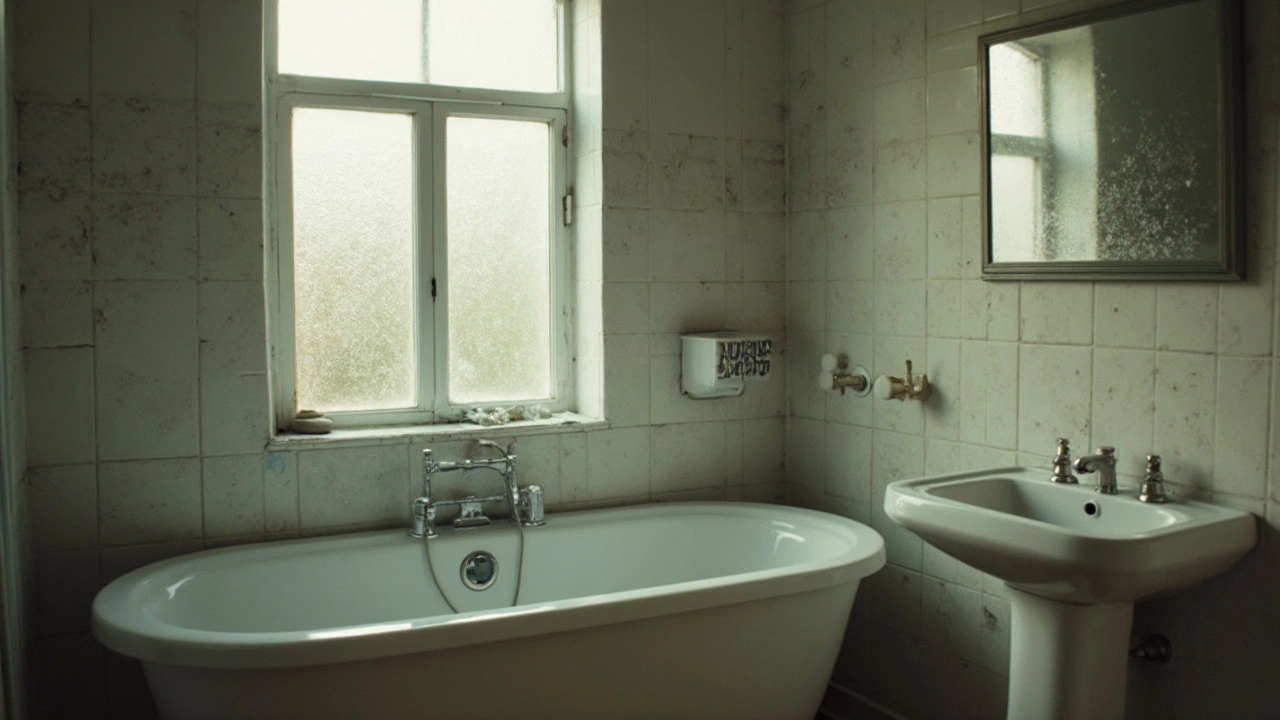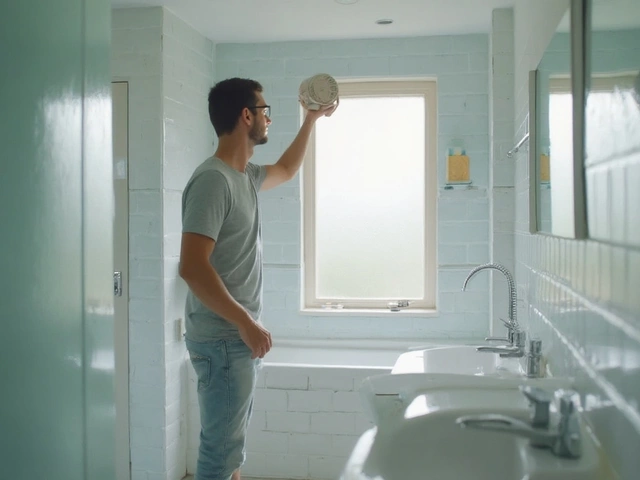If you’ve ever struggled with misty mirrors, peeling paint, or odd smells in your bathroom or kitchen, you’re probably wondering if installing (or fixing) an extractor fan is really worth it. Moisture builds up fast, and not just from showers or boiling pasta—everyday activities like drying laundry indoors can pump surprising amounts of water into the air. Without a way to kick that moisture outside, your home is basically a breeding ground for mold. Even cooking breakfast can leave grease clinging to walls and cupboards if there’s nowhere for the steam and smells to go.
Extractor fans tackle all that by pushing damp air straight outside, keeping rooms dry and fresh. They’re not just for looks, either—excess moisture slowly wrecks surfaces, encourages mold, and even messes with your health. So whether your current fan is rattling away uselessly or you’re wondering if you can skip getting one altogether, knowing what these gadgets actually do (and what happens if you go without) is going to save you headaches down the line.
- Why Bother With an Extractor Fan?
- Who Needs an Extractor Fan—And Who Doesn’t?
- What Goes Wrong Without Proper Ventilation
- Tips for Extractor Fan Repair and Upkeep
Why Bother With an Extractor Fan?
So, what’s the big deal about an extractor fan? For starters, it gets rid of damp air before it has the chance to cause chaos in your home. Without it, steam hangs around after showers and cooking, and all that moisture has to settle somewhere. Usually, that means your walls, ceilings, and even the inside of your cupboards end up damp. Over time, this leads to mold, which can trigger allergies and asthma, make your paint peel, and even start to rot your woodwork.
Bathrooms and kitchens pump out the most moisture, but open-plan homes spread it around even faster—so that problem doesn’t just stay where it starts. Replacing drywall, rehanging wallpaper, or scrubbing away black spots is more than a pain; it can get expensive fast. In fact, data from property management companies shows that mold removal jobs can easily cost between $400 and $3,000 depending on how bad it gets. Why deal with all that when a working extractor fan can keep things under control right away?
There’s a myth you can just crack a window and call it a day, but unless you like your house freezing or your energy bill going up, you’ll want something a bit more reliable. Extractor fans work fast and don’t let the heat escape. That means you stay comfy, your walls stay dry, and you skip the hassle of airing out every single time someone takes a hot shower or fries bacon.
Let’s not forget smells—cooking fish, last night’s curry, or sweaty gym socks don’t wash out easily. An extractor fan whips bad odors outside so they aren’t sticking to your furniture and clothes. It’s not just about comfort, either: Proper kitchen ventilation is required by building codes in a lot of places because lingering smoke and grease can be a fire hazard.
- Extractor fans reduce the need for repairs from moisture damage.
- They cut down mold growth and keep indoor air fresh.
- Less time spent cleaning grimy or moldy patches means more time doing literally anything else.
- Good ventilation helps you meet safety and health standards.
Who Needs an Extractor Fan—And Who Doesn’t?
Here’s the thing: some places absolutely need a extractor fan, while others can just about get away without one. Bathrooms and kitchens top the list. Taking hot showers without a fan? That’s a ticket to peeling paint, black mold around tile edges, and a funky smell that just won’t quit. Cooking up a storm but there’s no fan above your stove? Steam and grease end up everywhere, and your ceilings and walls will show it.
Homes with small or no windows in the bathroom or kitchen pretty much rely on extractor fans for ventilation. It’s actually a building code requirement in loads of places. In the UK, for example, new bathrooms must have an extractor fan if there’s no window. Renters, especially, notice more problems when landlords skimp on ventilation — you’ll spot mildew or water stains on ceilings way sooner.
- If anyone in the house has asthma or allergies, a good extractor fan in damp or steamy rooms isn’t just nice to have—it’s something you’ll really feel the difference with. All that damp air encourages mold, which is one of the biggest triggers.
- Got a home built before the 1980s, with solid walls and not much insulation? These homes trap moisture easily, so fans become even more important for keeping the space livable.
- Places with bad air circulation (like small inner bathrooms or enclosed kitchens) need fans the most. Relying on just cracking open a window isn’t enough, especially in cold or polluted areas.
There are a few situations where you might not desperately need an extractor fan. If you’ve got a spacious bathroom with a big window you open every time you bathe—especially if you’re in a dry climate—mold and damp might not be a problem. Same goes for big, open-plan kitchens that get regular fresh air. But, let’s be honest, most folks either forget to open the window or don’t want to grab a sweater just to air out the place in winter.
| Room Type | Extractor Fan Needed? |
|---|---|
| Small bathroom, no window | Yes, essential |
| Kitchen prone to steam and odors | Yes, highly recommended |
| Big bathroom with always-open window | Maybe, but not critical |
| Rarely-used guest loo with window | Unlikely, unless moisture builds up |
If you keep seeing damp spots, fogged-up glass, or any signs of black mildew, don’t try to just live with it. An extractor fan can be a real game changer, both for comfort and for keeping costly repairs at bay. If you’re skipping the fan, at least make sure your space can dry out quickly—or the problems stack up fast.

What Goes Wrong Without Proper Ventilation
Skipping an extractor fan can feel like no big deal, but the trouble shows up fast—especially in bathrooms and kitchens. The number one issue? Moisture. Hot showers and boiling water make steam, and without a fan to push it outside, that steam finds cracks and cold surfaces to settle on. This is why you’ll notice paint bubbling, wallpaper peeling, and black mold creeping along the edges of your ceiling. It’s not just ugly—it can wreck your house and even trigger allergies or asthma.
Mold is the star villain here. According to the NHS, “Damp and mold can affect your health, especially if you have respiratory problems.” That’s not just talk. Black mold loves warm, moist places. If you’ve got kids or someone older at home, breathing in mold spores is pretty much the last thing you want.
“Indoor dampness and mold are linked to increased risk of respiratory symptoms, allergies, and asthma.” – World Health Organization
If you think the damage stops at your health, think again. All that trapped moisture starts eating away at your house. You may spot:
- Black or green mold around window sills, grout lines, or ceiling corners
- Musty smells that just don’t shift, no matter how much air freshener you spray
- Peeling paint or bulging wallpaper (not a good look for any room)
- Damp patches or yellow stains on ceilings and walls
Kitchen without a kitchen fan? That air just gets greasy. Cooking without good ventilation leaves sticky residue on cupboards and walls, so cleaning becomes a nightmare. Food smells hang around for hours, and it’s not the nice kind—the lingering fried or fishy ones just hang out year-round.
Ever had to repair water-damaged plaster or replace rotten window frames? Not cheap. In the UK, the average cost to sort out mold properly (cleanup plus repairs) easily hits £400-£1000 depending on how far the damage spreads. That’s cash you could’ve saved with decent extractor fan repair or a new fan altogether.
Bottom line: Without proper ventilation, you’re making your place less comfortable, less healthy, and more expensive to fix down the line.
Tips for Extractor Fan Repair and Upkeep
A lot of folks totally ignore their extractor fan until stuff starts getting damp or the fan sounds like it’s chewing gravel. Keep your fan in shape, and you’ll avoid mold, save money, and steer clear of a full replacement.
First, give it a regular clean. Even top brands get clogged with dust, grease, and lint. Kitchen fans, in particular, get gunked up fast. Here’s a no-nonsense way to keep things running:
- Switch the power off. Safety first—don’t skip this.
- Remove the fan’s cover or grill. For most, it’ll pop off with a gentle pull or a screwdriver.
- Wipe down the grill and visible blades with a damp cloth or soapy water. Kitchen fans might need a degreaser.
- Use a soft brush or old toothbrush to get rid of stubborn dirt from the edges and corners.
- Check for any blockages in the vent or ducting. Even a small blockage can make the fan struggle or stop spinning.
- Let every part dry fully before reassembling and turning the power back on.
Notice a weird noise, or is the extractor fan not pulling air like it used to? That’s usually a sign of a worn-out motor, stuck impeller, or dodgy wiring. Most household extractor fan repairs are simple enough if you’re handy with a screwdriver and some patience.
- If the fan isn’t running at all, check the power at the wall. Fuses and circuit breakers are often the culprit—especially after a power surge.
- If it’s buzzing, unplug the unit and check for anything caught in the blades.
- If the switch is tough to press, the wall switch may need replacing. These cost just a few bucks at any hardware store.
When it comes to lifespan, most fans last about 7 to 10 years—sometimes longer if cleaned and serviced every six months. According to a 2021 UK survey on household ventilation, 65% of homes with annual extractor fan repair checks never reported mold compared to only 27% in homes that just "let it run." So a little attention now saves you a lot of hassle later.
| Problem | Possible Fix |
|---|---|
| Noise or rattling | Tighten screws, clean blades, remove blockages |
| No power | Check fuses, test power supply, replace switch |
| Poor airflow | Clean blades and ducts, check for vent blockage |
| Mold around fan | Check if fan vents outside; clean and run longer after shower/cooking |
One more thing—if you spot scorch marks, smell burning, or the fan trips the breaker, cut power and call an electrician right away. It’s rare, but better safe than sorry. Stay on top of these small checks, and your extractor fan will keep things dry and fresh for years.




